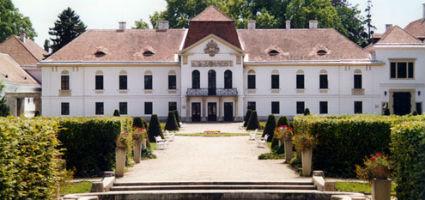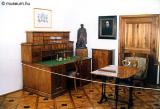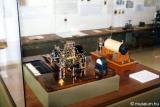2024. April 20. Saturday
István Széchenyi Memorial Museum - Nagycenk
 |
Address: 9485, Nagycenk Kiscenki u. 3.
Phone number: (99) 360-023
E-mail: soproni@gymsmuzeum.hu
Opening hours: 01.10-31.03.: Tue-Sun 10-17
01.04-30.09.: Tue-Sun 10-18 |
The Széchenyi mansion stands in the middle of a beautiful baroque park 12 kms from Sopron, beside road number 85. The building had been rebuilt several times when it got its final feature during the ownership of the "greatest Hungarian" István Széchenyi. In the eastern wing of the U shaped building group there is a stud, in the western so-called Red Mansion and in the flower house connected to it there is a hotel and a restaurant; in the middle part and in the western cross wing the Széchenyi István Memorial Museum was placed.
In the exhibition halls of the building built around 1750 visitors can see the material representing the life of the Széchényi family and the lifework of István Széchenyi István. A good number of documents proves the versatile activities of the count, whereas the interior recalls the atmosphere of the times.
The mockups and models of the first floor demonstrate the life of the practical Széchenyi. The first floor is not only an outstanding part of the exhibition because of the gigantic rococo stove and the famous Széchenyi portraits, but the beauty of the garden and the imposing length of the famous linden trees are best seen from here, too. The nearly 3 km long tree row was planted by Zsuzsanna Barkóczy wife of the owner Antal Széchényi) at the same time when the mansion was erected. This is a favourite avenue, at the end of which we can see the sarcophagus of Béla Széchenyi (elder son of István) and his wife.
The exhibition of the National Technical Museum was placed in the cross wing of the building. This represents the development of the Hungarian industry and a money historical exhibition from St. Stefan's denar to the appearing of the first 1000 Fts money note.
The Széchenyi-mausoleum in the cemetery beside the church is counted as a national pilgrimage. The building erected by Ferenc Széchenyi in the classicist style had been used as burial place for the family since 1810. Through the entrance hall we will get to the chapel, the frescoes of which were painted by István Dorfmeister, and the organ of which was used by Franz Liszt himself. From this a staircase leads down to the crypt, above of which we can see the inscription: "We were as you are now, and you will be as we are now." In the oval part of the crypt we can see the open oak coffin of Pál Széchenyi died in 1710, and the iron box keeping the skull of István Széchenyi.
In the exhibition halls of the building built around 1750 visitors can see the material representing the life of the Széchényi family and the lifework of István Széchenyi István. A good number of documents proves the versatile activities of the count, whereas the interior recalls the atmosphere of the times.
The mockups and models of the first floor demonstrate the life of the practical Széchenyi. The first floor is not only an outstanding part of the exhibition because of the gigantic rococo stove and the famous Széchenyi portraits, but the beauty of the garden and the imposing length of the famous linden trees are best seen from here, too. The nearly 3 km long tree row was planted by Zsuzsanna Barkóczy wife of the owner Antal Széchényi) at the same time when the mansion was erected. This is a favourite avenue, at the end of which we can see the sarcophagus of Béla Széchenyi (elder son of István) and his wife.
The exhibition of the National Technical Museum was placed in the cross wing of the building. This represents the development of the Hungarian industry and a money historical exhibition from St. Stefan's denar to the appearing of the first 1000 Fts money note.
The Széchenyi-mausoleum in the cemetery beside the church is counted as a national pilgrimage. The building erected by Ferenc Széchenyi in the classicist style had been used as burial place for the family since 1810. Through the entrance hall we will get to the chapel, the frescoes of which were painted by István Dorfmeister, and the organ of which was used by Franz Liszt himself. From this a staircase leads down to the crypt, above of which we can see the inscription: "We were as you are now, and you will be as we are now." In the oval part of the crypt we can see the open oak coffin of Pál Széchenyi died in 1710, and the iron box keeping the skull of István Széchenyi.

